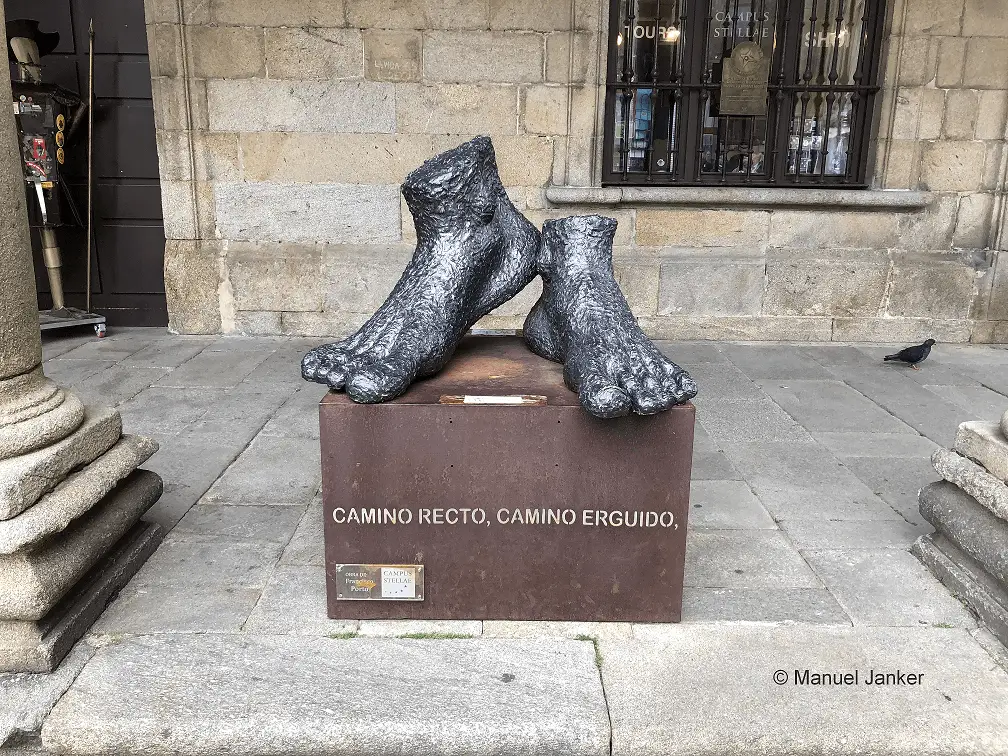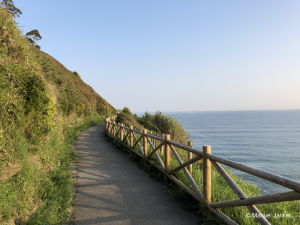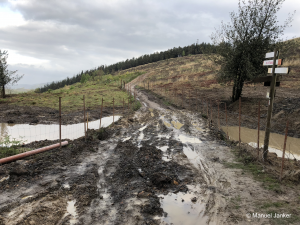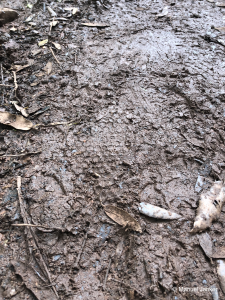Long-distance hiking with barefoot shoes – my versatile companion on the camino de la costa
920 kilometers from Saint Jean de Luz to Santiago de Compostela, then on to "kilometer zero" in Fisterra. I really thought I could walk barefoot along the Atlantic coast from France to the end of the world. That's how it is sometimes with thinking: it's easier if you ignore the important things. But it turned out that I packed my backpack with a lot of junk from the year 1800 and a pair each of leguanos (classic model), Vivos, Chalas and old worn-out Adidas running shoes. These four pairs of shoes and about 920 kilometers from Saint Jean de Luz to Santiago de Compostela, then on to "kilometer zero" in Fisterra (Cap Finisterre).

leguanos are really wellness for hard-working feet
What can I say in retrospect? I would have reached my goal with three pairs of shoes. I wore the Chalas for a short time at the end "after work" so that I hadn't had them with me for no reason. Otherwise, I estimate the wearing ratio as follows: 60% Adidas, 35% leguanos and 5% Vivos.
 After all, “along the coast” was not as natural and romantic as it might sound, because most of the route ran along roads and other paved paths. If you consider that roads were built for fast, moving traffic and that this has nothing to do with the natural surface on which humans run, it is easy to conclude that running barefoot on asphalt puts too much strain on the body and does more harm than good. So, considering the total distance and the physical fitness and health required for it, I also used Adidas on the hard surfaces. The leguanos were also used there now and again, though, because changing shoes during the day was a little bit of wellness for my hard-working feet. I mainly wore them on the forest and meadows, as well as on sandy and gravel trails.
After all, “along the coast” was not as natural and romantic as it might sound, because most of the route ran along roads and other paved paths. If you consider that roads were built for fast, moving traffic and that this has nothing to do with the natural surface on which humans run, it is easy to conclude that running barefoot on asphalt puts too much strain on the body and does more harm than good. So, considering the total distance and the physical fitness and health required for it, I also used Adidas on the hard surfaces. The leguanos were also used there now and again, though, because changing shoes during the day was a little bit of wellness for my hard-working feet. I mainly wore them on the forest and meadows, as well as on sandy and gravel trails.
Barefoot runners are still a rarity on the Way of St. James
The first encounters in a hostel just before San Sebastian showed that barefoot runners are a rarity on the Way of St. James. I met Bruno, a Frenchman who is familiar with barefoot shoes but only wears them indoors and uses hiking boots outside. Otherwise, I was looked at with disbelief and curiosity and listened to stories about tired, sore feet, lots of blisters and heavy luggage. With four pairs of shoes, I was an oddity simply because of the number of them; blisters were also completely foreign to me and my relatively small luggage in a 33L backpack weighing around 10kg drew questioning looks from other hikers of all nations. But of course I was not spared the tiredness, because the new strain on the feet is noticeable regardless of the shoes.
Even pilgrims in the fast lane stopped briefly to ask me about the leguanos
So I was able to report diligently about leguano and the feeling of hiking in barefoot shoes: about positive side effects such as the light weight on the foot, which is a significant difference to heavy, stiff hiking shoes, or the small, flexible size, which is very useful for packing. In addition, I never had to worry about being too lonely or lacking topics of conversation, which were taken away from me by the curiosity of my fellow pilgrims. At the same time, it was inevitable that I got on particularly well with those who brought their own experiences of barefoot walking with them.
My comparison: Which (barefoot) shoe for which route?
Now the length and condition of the route, the duration of the trip and the different weather conditions allow an optimal comparison between my leguano, Vivobarefoot Primus lite and, from observation, Manu's Vibram FiveFingers.
Sole: The sole of the leguanos is a little thicker and softer than that of the Vivos, so I could wear the former on asphalt every now and then and walk a few kilometers. I had to wear the Vivos on soft ground because the impact on feet and joints was too high due to the thin 3mm sole. Here the leguano cushions a little more, which can be seen as positive or negative depending on your personal goal. If you want to be as fast and as natural as possible barefoot, the thinner sole is recommended. But if you spend hours walking on asphalt sidewalks in the city, the cushioned soles might be more suitable. The FiveFingers have different thickness soles depending on the model, but are certainly suitable for hikes and walks over longer distances.
Waterproofness : It should also be said that neither leguano nor Vivo are waterproof, although the soles of both can withstand a lot and can easily survive mini puddles. But above the sole, both let water through. The FiveFinger can't keep up with that, as liquids also penetrate the shoe from below. So your feet are always wet and I wonder whether they are suitable for the outdoors. Serious athletes don't just go outside when the sun is shining.
 Upper material: The Vivos are made of a firmer material and feel a little more uncomfortable to me when wet than a leguano, which hugs the foot and dries quickly thanks to body heat. I already commented on the material of the FiveFingers in the last article . It is so firm that it does not adapt to the foot or toe shape, but the feet have to fit into the shoe. I see this as a major disadvantage. Every foot fits in leguano and Vivo, as the material of the former is flexible and the space in the latter is sufficient and adapted to the natural shape of the foot. The firmer material of the FiveFingers and Vivos is impermeable, so nasties like thorns or glass and the like have to stay outside. A small burr can sometimes annoy the leguano wearer, as they not only prick the foot, but also cling tightly to the shoe and are therefore difficult to remove. Foot climate: Otherwise, I find the Vivos to be airier, while the leguanos store heat and develop a comfortable temperature on the foot. That's why I tend to leave the Vivos at lower temperatures and prefer the leguanos. They have already proven themselves very well in cold weather. With a second pair of socks you can even get a few more degrees out of it. And when it's wet in winter you can also use waterproof socks to keep your feet dry and warm. This is certainly also useful for protecting yourself from colds. In summer it's the other way round. The leguanos can store so much heat that it becomes unbearable for the foot. In future I will use light colors and the sneaker version.
Upper material: The Vivos are made of a firmer material and feel a little more uncomfortable to me when wet than a leguano, which hugs the foot and dries quickly thanks to body heat. I already commented on the material of the FiveFingers in the last article . It is so firm that it does not adapt to the foot or toe shape, but the feet have to fit into the shoe. I see this as a major disadvantage. Every foot fits in leguano and Vivo, as the material of the former is flexible and the space in the latter is sufficient and adapted to the natural shape of the foot. The firmer material of the FiveFingers and Vivos is impermeable, so nasties like thorns or glass and the like have to stay outside. A small burr can sometimes annoy the leguano wearer, as they not only prick the foot, but also cling tightly to the shoe and are therefore difficult to remove. Foot climate: Otherwise, I find the Vivos to be airier, while the leguanos store heat and develop a comfortable temperature on the foot. That's why I tend to leave the Vivos at lower temperatures and prefer the leguanos. They have already proven themselves very well in cold weather. With a second pair of socks you can even get a few more degrees out of it. And when it's wet in winter you can also use waterproof socks to keep your feet dry and warm. This is certainly also useful for protecting yourself from colds. In summer it's the other way round. The leguanos can store so much heat that it becomes unbearable for the foot. In future I will use light colors and the sneaker version.
 And one last nice side effect that I would like to mention here is that the leguanos leave clear traces in the sand and earth and it is practically impossible to get lost even if you get lost: a phenomenon that occurs every now and then on the Way of St. James.
And one last nice side effect that I would like to mention here is that the leguanos leave clear traces in the sand and earth and it is practically impossible to get lost even if you get lost: a phenomenon that occurs every now and then on the Way of St. James.
My conclusion: Which shoes are suitable for a long-distance hike
All in all, I can say that after some time and with increasing experience, you start to notice the different advantages and disadvantages of different models. I therefore think it is a good idea to equip yourself with a wide range of equipment in order to be prepared for the different requirements. I will soon be hiking the Israel National Trail with Manu. On this hike, only leguanos are on board . Five weeks await us at 15 to 20°C over mountains, through small and large towns, through the forest and on the beach. Equipped with a tent, we are free to plan our days and routes and are open to spontaneous excursions. The best conditions for many experiences, valuable memories and contemplative days to end the year. And now I wish you a good time too. Until next time. Your Bea Further report on the northern route: 600 kilometers on the Spanish coastal path with leguano barefoot shoes